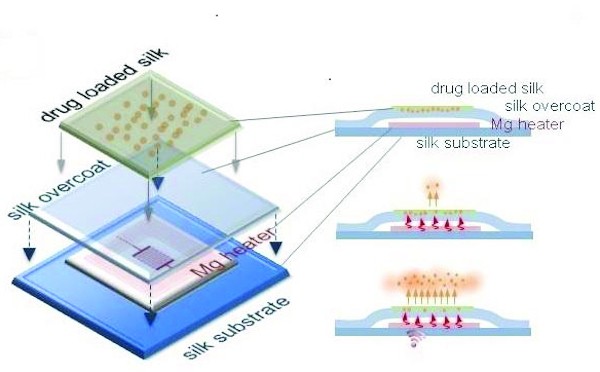The silk and magnesium devices then harmlessly dissolved in the test animals. The technique, developed at Tufts University in collaboration with the University of Illinois at Champaign-Urbana, had previously been demonstrated only in vitro. The research is published online in the Proceedings of the National Academy of Sciences.
‘This is an important demonstration step forward for the development of on-demand medical devices that can be turned on remotely to perform a therapeutic function in a patient and then safely disappear after their use, requiring no retrieval,’ said senior author Fiorenzo Omenetto, professor of biomedical engineering and Frank C. Doble professor at Tufts School of Engineering. ‘These wireless strategies could help manage post-surgical infection, for example, or pave the way for eventual ‘wi-fi’ drug delivery.’

According to Tufts, implantable medical devices typically use non-degradable materials that have limited operational lifetimes and must eventually be removed or replaced.
The new wireless therapy devices are robust enough to survive mechanical handling during surgery but designed to harmlessly dissolve within minutes or weeks depending on how the silk protein was processed, the paper’s first author, Hu Tao, Ph.D said in a statement.
Each fully dissolvable wireless heating device is said to have consisted of a serpentine resistor and a power-receiving coil made of magnesium deposited onto a silk protein layer. The magnesium heater was encapsulated in a silk ‘pocket’ that protected the electronics and controlled its dissolution time.
Devices were implanted in vivo in S. aureus infected tissue and activated by a wireless transmitter for two sets of 10-minute heat treatments. Tissue collected from the mice 24 hours after treatment showed no sign of infection, and surrounding tissues were found to be normal. Devices completely dissolved after 15 days, and magnesium levels at the implant site and surrounding areas were comparable to levels typically found in the body.
The researchers also conducted in vitro experiments in which similar remotely controlled devices released the antibiotic ampicillin to kill E. coli and S. aureus bacteria. The wireless activation of the devices was found to enhance antibiotic release without reducing antibiotic activity.





April 1886: the Brunkebergs tunnel
First ever example of a ground source heat pump?